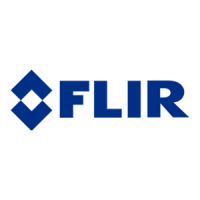910-0001-00-INS -R02 Page 26 of 53
Information contained in this document pertains to a Canadian origin product that is controlled as "dual use" by the Canadian government. However, when in
the United States or possessed by a US person, it may be considered a defense article from the US Government's perspective. US government authorization
may be required for re-transfer to a foreign person. If you have any questions, please contact FLIR's Global Trade Compliance group at
exportquestions@flir.com .
WARNING!
e used to ensure that the radar is properly secured.
To ensure maximum performance, the radar must turn at a steady speed. Therefore, the mounting surface
should follow the following criteria:
• Flat and level to within 1/2° on level terrain, to properly direct the radar energy. If needed, it is
possible to tilt the radar assembly up to 22.5º to follow the terrain contour.
• The mount area should be designed such that rain water does not accumulate.
• The mount area must provide enough clearance for the power/data connector and for the installer
to have room to manually mate the power/data cable to the connector.
• The screws need to be long enough to go through the mounting surface plus 12.7 mm (1/2”) plus
the washer thickness. If the mounting surface is a 6.3 mm (1/4”) plate, then the screws (threads)
should be 19 mm (3/4”) in length.
• The maximum screw penetration into the radar should not exceed 15.7 mm (~5/8”).
• Torque should not be excessive but should result in no rocking movement whatsoever.
• The use of a compound such as Loctite® is recommended to maintain the screws in the desired
position. A lock washer is not required.
• The two aerating vents on the bottom of the radar units should not be obstructed.

